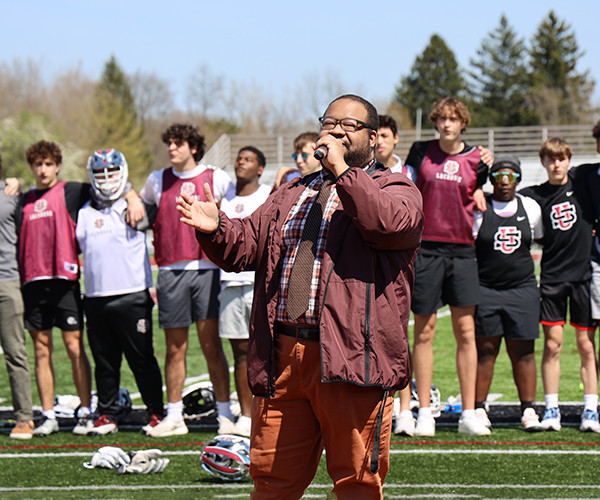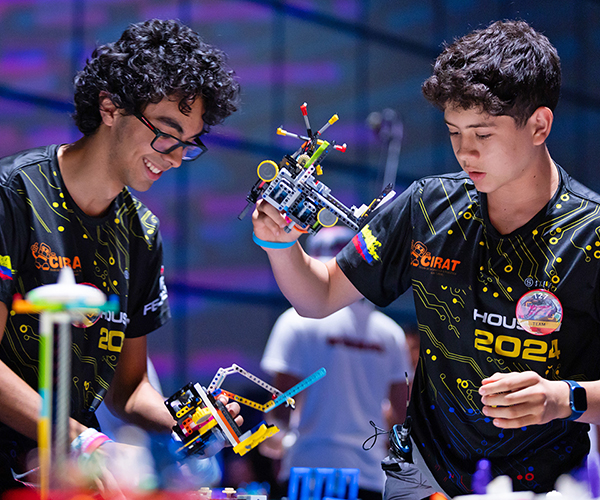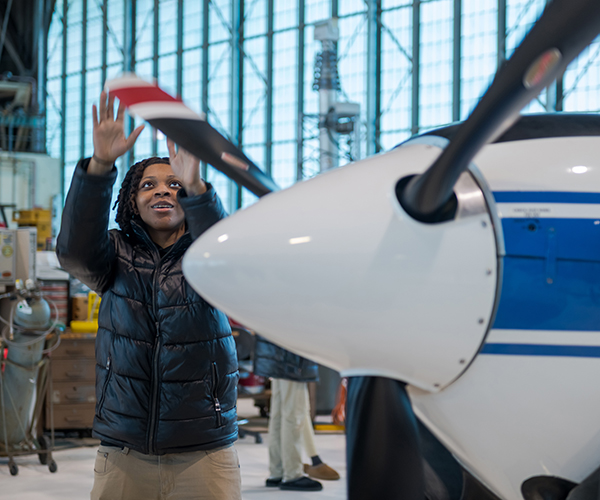Sara Laughlin sat in a classroom at Lorain County Community College and listened to her professor read over the syllabus for English 161 College Composition.
It was her first college class. She was 16 years old, a junior in high school, and she was terrified.
She was expected to do everything any other college student would do: all the readings, all the tests, all the papers. "He was just throwing us out there," Laughlin says. "We wrote 20 papers in 16 weeks, but I learned so much."
Laughlin, now a senior at Firelands High School in Lorain County, is part of a growing group of teenagers in Northeast Ohio who are taking college courses in high school and getting credit for both.
In 2009, the Ohio Department of Education reported that 4,495 students were enrolled in what is called postsecondary enrollment options in Northeast Ohio. Our region comprises nearly one-third of all students in the state participating in the program.
High school students have long traveled to college campuses thanks to arrangements made between universities and local school districts. But now, there is a push to take college courses to high schools, thereby dramatically increasing the number of students who will be entering college as freshmen with college credit to their name.
Just recently, the Ohio Board of Regents gave the Northeast Ohio Council on Higher Education and College Now Greater Cleveland a $450,000 grant aimed at increasing the number of students who attend college and pursue dual enrollment.
A major part of this plan includes training and credentialing high school teachers with master's degrees in their respective content areas to be adjunct faculty members who will teach college-level courses at local high schools.
One of the primary benefits of high school graduates entering college with academic credits is that those students are more likely to graduate with a four-year degree.
This ties nicely with a CEOs for Cities finding that suggests increasing the number of people 18 and older in Northeast Ohio with a four-year-degree by 1 percent would result in 31,000 more college graduates and a resulting $2.8 billion economic boost.
"It is extremely important that everyone recognize the importance of obtaining a college degree in this economy," says Ann Womer Benjamin, executive director of the Northeast Ohio Council on Higher Education. "Parents and students and counselors need to work together to help students earn college credit while they are still in high school."
Postsecondary enrollment is also often free for the student because state funds that would normally go to a school district are instead funneled to colleges and universities to cover tuition, fees and books for students taking those courses. As a result, some students are graduating high school with enough credits to make them seniors in college, which allows them to pursue second and even third degrees, or go to graduate school after one year of undergraduate work.
As a student at Lowell Elementary School in Lorain (which has since been closed), Ralston remembers getting homework, taking it home and sitting at the table with a parent to go over the assignments.
Later, when he was at Whittier Middle School, a speaker told his class about Early College at Lorain County Community College. He could, if he wanted, spend his four high school years on a college campus, taking college classes. And it would be free.
"We're not the richest family ever," Ralston says, "so any help I could get would be awesome."
Early College agreements are sprouting up throughout Northeast Ohio. These programs are aimed at students who will be first-generation college students and consist of those students spending all four years of their high school career on a college campus.
Ralston and several friends signed up for Early College through LCCC, and when most students his age were going to a high school for the first time, he was traveling to a college campus. He spent the first year taking regular high school classes. But as a sophomore, he and his friends were thrown into a handful of college-level courses, including English 161.
"We were talking to another student, who was in college, and he said, 'How old are you guys?' " Ralston says. "He was shocked. He talked about how long it took him to get where he was at. He told us to keep up the good work. That made me feel so mature."
More than 2,000 high school students take college courses for credit at the community college, says Cindy Kushner, director of marketing and outreach initiatives at LCCC.
About 300 participate in Early College, a program that was started with a grant from the Bill and Melinda Gates Foundation.
"Usually by their junior year, they are engaged in all college courses," Kushner says, "most of which count toward high school and college. We're squeezing out repetition."
Ralston was one of 53 students in spring 2010 to graduate from the college with an associate's degree, something he did two weeks before he actually received his high school diploma.
He has since enrolled in LCCC's nursing program, which is run in conjunction with the University of Akron. The 19-year-old will be a registered nurse before he can legally drink an alcoholic beverage, and he plans to continue his schooling to pursue a bachelor's of science in nursing and eventually a master's degree.
Currently, he the youngest student doing clinicals at Southwest General Hosital in Berea. He also works part time as a nurse's aide on the rehabilitation floor at Mercy Hospital.
"Some of the patients ask me, 'Are you old enough to be here?' " he says. "They are pretty surprised."
By and large, just about every student who goes through the Early College program continues on toward a bachelor's degree, Kushner says. About 40 percent stay at LCCC, while others transfer to other universities to continue their coursework.
"From the research we have been seeing, high school students who earn somewhere between 10 and 12 credits while they are in high school, they are substantially more successful than students who did not complete college credentials," Kushner says. "If we can give them a taste of college and build on that momentum, their chances for success increase substantially."
At Kent State University, Gloria Dunnivan, director of dual enrollment programs, says that 60 percent of the students who take dual enrollment courses at the university ultimately enroll full time there, based on figures from 2006 to 2009. And 89 percent of those students graduate in three years (2 percent have so many credits coming in they graduate in one year).
"They know how to take a college class," Dunnivan says. "They know the rigor. They know the syllabus. They know how to use the online system. They already know all that, so they don't have to learn it all as incoming freshmen."
In 2009, Kent State had 450 full-time students who were enrolled at the university that previously participated in the dual enrollment program. The goal is to grow that number by about 5 percent each year, Dunnivan says.
One of those students was Paisley Rae Stovall, who started the postsecondary enrollment program at Kent State when she was a sophomore at Streetsboro High School.
Stovall is no stranger to skipping ahead. She skipped the fifth grade when she was in middle school.
"I didn't think high school challenged me enough," Stovall says. "I wanted something difficult and challenging that would make me think, make me mature a little faster."
This fall, Stovall entered Kent State like hundreds of other freshmen. She has been going through orientation and is taking the same freshman class everyone takes.
The biggest difference, though, is that from a credit standpoint, Stovall is technically a senior.
She came into Kent State with 108 credits. Since she's already completed a bulk of her college education, she has decided to triple major in anthropology, Pan-African studies and music.
"After triple-majoring," Stovall says, "I probably won't graduate for three years."
That's still one year faster than most students with one major will graduate, though.
Coupled with the grant from the Ohio Board of Regents, there could be an explosion in the number of PSEO students, and that growth will come in college classes being offered in local high schools.
Kent State currently has teachers from seven school districts taking courses this fall to get them certified to be an adjunct professor.
Lorain County Community College is working with three high schools now in the hopes of expanding dual enrollment options. This likely will include high school teachers team-teaching college courses with LCCC faculty.
"I think we need a community-focused effort between universities, all of the schools and all of the intermediary partners," says Lee Friedman, CEO of College Now, which worked with 20,000 people in 100 school buildings last year to provide greater access to college.
"We all agree that we need to laser focus on making sure our youth get the education they need, one that is a fit for them individually," she continues. "We need to find a way that every individual in the community can be a productive member of our society."
LCCC will launch a pilot program in the spring that will be based around this team-teaching model, Kushner says.
Courses will be taught in the high schools using LCCC syllabi and books. And because it's delivered in the school, entire classes can participate, instead of just one or two who travel to the LCCC campus for classes.
"One of the primary advantages is that students transition to college more prepared," she says. "When you go in prepared, you are more successful. There are less stop-outs and fall-outs. This plays a big role in preparation and success at the next level."
She knows this because she has already taken a general psychology course at LCCC.
Ultimately, she wants to work with children who are in the hospital. She thinks she'll be able to graduate with her four-year degree in 2 1/2 to three years.
"I really like to help people," she says. "I'm really interested in different ways that kids develop."
While she spends the majority of her school day on the Elyria campus — she is at Firelands from 7 to 8:50 a.m. and LCCC from 9:30 a.m. to 2:15 p.m. — she has stayed active at her high school too.
She is running for senior class president, and she participates in the agricultural science program, often referred to as Future Farmers of America.
Initially, Ralston says he had friends who teased him about doing the Early College program. "They wanted to go to high school and have fun," he says.
But he stayed active at his high school, playing sports and dealing with typical high school drama, despite spending all of his time on the LCCC campus.
"Early College had a regular high school feel," he says. "I didn't miss out on the high school experience, and I got the college benefits."
After a year of Early College, Ralston says, those friends who initially teased him wished they had gone too.



